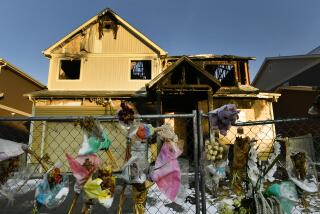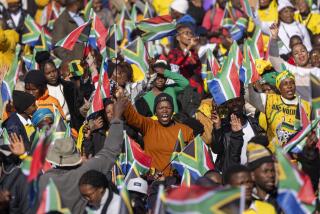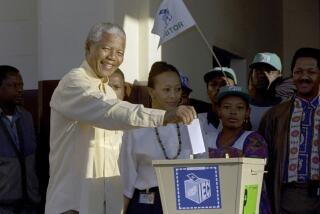Migrants burned alive in S. Africa
DIEPSLOOT, SOUTH AFRICA — The brutal apartheid-era practice of setting opponents on fire has been revived in this country’s crowded, litter-strewn shantytowns. But now the victims are foreign migrants.
Anger over unemployment and rising prices and simmering resentment against illegal foreign migrants have exploded into xenophobic violence in South Africa, with at least 22 people slain in the last 10 days. Hundreds more have been injured and as many as 10,000 have fled their homes, as analysts struggle for explanations as to what triggered the violence.
South Africans woke Monday to shocking front-page images of a man in flames, one of several victims to be burned alive. Several newspapers reported that onlookers in the township of Reiger Park, east of Johannesburg, laughed as the man rocked in agony.
Nobel Peace Prize laureate Desmond Tutu summed up the mood of despair with a plea to “please stop the violence now. This is not how we behave. These are our sisters and brothers. Please, please stop.”
South African President Thabo Mbeki also called for an end to the “shameful and criminal acts.”
During apartheid, political violence sometimes involved setting victims on fire, on occasion after “necklacing” them with spare tires that pinned their arms to their sides.
The victims of the latest violence are mainly southern African migrants, in particular Zimbabweans, drawn to South Africa in hopes of finding jobs. South Africans also have been attacked.
Violence in several neighborhoods continued Monday, with attackers burning dozens of foreigners’ shacks and families fleeing their homes. The body of a man who had been chopped and burned was recovered by police in Ramaphosa township, east of Johannesburg. Newspaper reports suggested he was Malawian.
Victims and witnesses describe chilling attacks: hundreds of people armed with axes, clubs and metal bars going from shack to shack, purging districts of foreigners; victims being clubbed insensible with concrete slabs and then burned, or being locked into their shacks, which were then set alight.
In Diepsloot, northwest of Johannesburg, one of the townships hit by violence, locals described heavily armed attackers singing “Umshini Wami,” or “Bring Me My Machine Gun,” a song that has its origins in the ruling African National Congress’ armed struggle against apartheid. The song was linked to ANC President Jacob Zuma’s campaign to become party leader.
“People were singing that song and attacking people,” said Jimmy Thutse, 54, a maintenance worker and Diepsloot resident. “People are saying these Zimbabweans must go home now because they are taking our jobs. They don’t need these people any more. Everyone is saying, ‘We are full here. We can’t get a job. We can’t get anything.’ ”
Zuma has condemned the attacks. However, some ANC politicians have suggested the violence of recent days is primarily criminal, not xenophobic, in nature.
But Vincent Williams, an analyst with the Southern African Migration Project, said surveys in 1997 and 2006 showed South Africa was among the least tolerant nations toward migrants. One-quarter of South Africans wanted a ban on foreign migrants and about 22% wanted them sent home, according to the 1997 survey. The results were almost the same in 2006.
“Over 10 years anti-foreigner sentiment remained more or less the same, and in some cases increased, particularly from the point of view of resource issues: access to education, access to employment, access to healthcare,” he said, adding that incidents of violence had occurred since the 1990s.
The clinic in Diepsloot was packed Friday when a crowd of people arrived carrying metal bars, clubs and axes, determined to purge all foreigners. Almost all of the patients were foreign migrants.
One mob leader walked into the clinic and ordered all the street vendors, who tend to be from Zimbabwe or Mozambique, to stand up. He ordered staff to close the clinic because the patients were foreigners, not South Africans.
“People started standing up and going out one by one. Everybody just left,” said a nurse who asked not to be named because the government forbids healthcare personnel to speak to journalists. The clinic stayed open, but no more patients came that day.
About half a mile away, about 100 angry men rampaged in a neighborhood as South African residents showed the attackers where foreigners lived.
“Some were already pointing to say that this shack belongs to a foreigner. Most of the people don’t want us,” said resident Decent Mgcini, a 20-year-old Zimbabwean who is unemployed but earns about $135 a month doing odd jobs. “I was angry. I was terrified. Look at that door. They put an ax through the door.”
Williams, the analyst, said the attacks were more likely to have been organized than spontaneous, which would explain how the violence spread rapidly from one township to another. Similar violence in the ‘90s was organized, he said.
“It’s organized. It’s not spontaneous,” he said. “To me, the question of who it is, is a more important question than why it is happening.”
Paul Graham of the Institute for Democracy in South Africa said xenophobia was deep-rooted in South Africa and getting worse. But he said the trigger for the “outbreak of cleansing” was unclear.
“We can see the tinder lying on the ground which could blaze up, but who struck the match is not clear,” he said.
--
More to Read
Sign up for Essential California
The most important California stories and recommendations in your inbox every morning.
You may occasionally receive promotional content from the Los Angeles Times.










